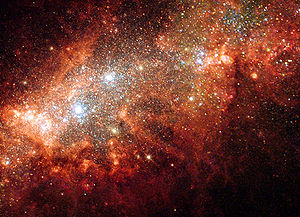- NGC 1569
-
NGC 1569 
A Hubble Space Telescope (HST) image of NGC 1569.
Credit: HST/NASA/ESA.Observation data (J2000 epoch) Constellation Camelopardalis Right ascension 4h 30m 49.1s[1] Declination +64° 50′ 53″[1] Redshift -104 km/s[1] Distance 7.8 ± 2.0 Mly (2.4 ± 0.6 Mpc)[2] Type IBm[1] Apparent dimensions (V) 3′.6 × 1′.8[1] Apparent magnitude (V) 11.9[1] Notable features Contains two super star clusters Other designations VII Zw 016,[1] Arp 210[1] See also: Galaxy, List of galaxies NGC 1569 is a dwarf irregular galaxy in Camelopardalis. While this faint galaxy is not a popular amateur astronomy target, it is well studied by professional astronomers, who are interested in the history of star formation within the galaxy. The galaxy is relatively nearby. Consequently, the Hubble Space Telescope can easily resolve the stars within the galaxy.[3] The distance to the galaxy was previously believed to be only 2.4 Mpc (7.8 Mly).[2] However, in 2008 scientists studying images from Hubble calculated the galaxy's distance at nearly 11 million light-years away, about 4 million light-years farther than previous thought.[4][5]
Contents
Star formation
NGC 1569 contains two prominent super star clusters with different histories.[3][6] Both clusters have experienced episodic star formation. Super star cluster A, located in the northwest of the galaxy, contains young stars (including Wolf-Rayet stars) that formed less than 5 million years ago as well as older red stars.[6][7] Super star cluster B, located near the center of the galaxy, contains an older stellar population of red giants and red supergiants.[3][6][7] Both of these star clusters are thought to have masses equivalent to the masses of the globular clusters in the Milky Way. Numerous smaller star clusters with relatively young ages have also been identified.[3] These results, along with the results from other dwarf galaxies such as the Large Magellanic Cloud and NGC 1705, demonstrate that star formation in dwarf galaxies does not occur continuously but instead occurs in a series of short, nearly instantaneous bursts.
Blueshift
NGC 1569 is exceptional in that its spectrum is blueshifted.[1] This means that the galaxy is moving towards the Earth. In contrast, the spectra of most other galaxies are redshifted because of the expansion of the universe.
References
- ^ a b c d e f g h i j k "NASA/IPAC Extragalactic Database". Results for NGC 1569. http://nedwww.ipac.caltech.edu/cgi-bin/nph-objsearch?search_type=Obj_id&objid=10917&objname=609&img_stamp=YES. Retrieved 2007-03-15.
- ^ a b Makarova, L. N.; Karachentsev, I. D. (2003). "On the Distance to Nearby Dwarf Galaxy NGC 1569". Astrophysics (English translation of Astrofizika) 46 (2): 144–150. Bibcode 2003Ap.....46..144M. doi:10.1023/A:1024055702766.
- ^ a b c d D. A. Hunter, R. W. O'Connell, J. S. Gallagher, T. A. Smecker-Hane (2000). "The Star Clusters in the Starburst Irregular Galaxy NGC 1569". Astronomical Journal 120 (5): 2383–2401. arXiv:astro-ph/0009280. Bibcode 2000AJ....120.2383H. doi:10.1086/316810.
- ^ Grocholski, Aaron J.; Aloisi, Alessandra; van der Marel, Roeland P.; Mack, Jennifer; Annibali, Francesca; Angeretti, Luca; Greggio, Laura; Held, Enrico V.; Romano, Donatella Sirianni, Marco; and Tosi, Monica (October 20, 2008). "A New Hubble Space Telescope Distance to NGC 1569: Starburst Properties and IC 342 Group Membership". Astrophysical Journal Letters 686 (2): L79–L82. Bibcode 2008ApJ...686L..79G. doi:10.1086/592949.
- ^ Hubble Resolves Puzzle about Loner Starburst Galaxy Newswise, Retrieved on November 17, 2008.
- ^ a b c L. Origlia, C. Leitherer, A. Aloisi, L. Greggio, M. Tosi (2001). "The Stellar Content of the Super-Star Clusters in NGC 1569". Astronomical Journal 122 (2): 815–824. arXiv:astro-ph/0105195. Bibcode 2001AJ....122..815O. doi:10.1086/321152.
- ^ a b G. J. Bendo, R. D. Joseph (2004). "Nuclear Stellar Populations in the Infrared Space Observatory Atlas of Bright Spiral Galaxies". Astronomical Journal 127 (6): 3338–3360. arXiv:astro-ph/0403133. Bibcode 2004AJ....127.3338B. doi:10.1086/420712.
External links
- NGC 1569 at ESA/Hubble
- NGC 1569 on WikiSky: DSS2, SDSS, GALEX, IRAS, Hydrogen α, X-Ray, Astrophoto, Sky Map, Articles and images
- Astronomy Photo of the Day: NGC 1569
Categories:- Dwarf irregular galaxies
- Camelopardalis constellation
- NGC objects
- UGC objects
- PGC objects
- Arp objects
Wikimedia Foundation. 2010.
